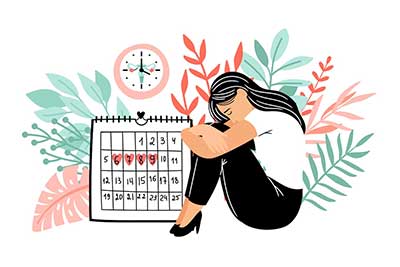Date: 01/03/2023
Relevance: GS-1: Women Empowerment and related Issues.
Relevance: GS-2: Health and related issues.
Key Phrases: Menstrual Period Leave, Economic Survey, Literacy Gap, Gender Disparity, Periodic Labour Force Survey, NSO, Women Empowerment, Workforce, Unemployment Rate, Strategy for New India at the rate75, SDG 8
Context:
- The Supreme Court of India recently directed a petitioner to take up the issue of menstrual leave with the Ministry of Women and Child Development.
Key Highlights:
- In India, only Bihar and Kerala grant menstrual leave to women.
- Bihar had introduced paid menstrual leave for two days for women employees as far back as 1992.
- In Kerala, CM Pinarayi Vijayan had on January 19 announced that the state government would provide a three-day period leave for female students.
Menstrual Period Leave:
- Menstrual leave or period leave refers to all policies that allow
employees or students to take time off when they are experiencing menstrual
pain or discomfort.
- In the context of the workplace, it refers to policies that allow for both paid or unpaid leave, or time for rest.
- Menstrual leave policies are designed with a view to allow women time off if they suffer from symptoms which may hamper their functioning and productivity.
- Menstrual period leave is often seen as “medicalising a normal biological process”.
- Though menstruation is a biological process, it is accompanied by
cramps, nausea, back and muscle pains, headaches, etc.
- Most women experience a menstrual cycle of 28 days— a normal cycle may vary from 23 to 35 days.
- More than half of those who menstruate experience pain for a couple of days a month; for some it is debilitating enough to hamper daily activities and productivity.
- Additionally, these can take a debilitating form amongst menstruating people who suffer from polycystic ovary syndrome (PCOS) and endometriosis.
- In India, 20 percent of menstruators (an inclusive term referring to women, trans men, and non-binary persons who menstruate) have PCOS and approximately 25 million suffer from endometriosis.
- The intensity of pain can vary for individuals for a variety of reasons.
- Mandatory period leave is an affirmative action policy that acknowledges this reality.
- However, not everyone - not even all those who menstruate - is in
favour of menstrual leave.
- Some believe either that it is not required or that it will backfire and lead to employer discrimination against women.
Benefits of Menstrual Leave:
- Menstruation is a biological process and women should not be discriminated against in educational institutions and workplaces.
- Menstrual period leave will reduce burnout and increase productivity.
Costs of Menstrual Leave:
- The major opposition to a menstrual leave policy is the fear of bias in hiring due to the financial costs to employers.
- It is often equated to the decline in the labor force participation of women following the introduction of mandatory paid maternity leave.
- Discriminatory hiring has been a cause of concern in many countries.
Experience at Global Level:
- In many European and North American countries, mandatory paid
paternity leaves, parental leave (shared by both parents), and
remote/flexible working hours for parents with children under 12 years of
age are provided.
- Additionally, some governments provide financial support to employers to help cover the costs of paying employees on maternity/parental leave.
- There are also stringent penalties for discrimination in the hiring/promotion of pregnant persons as well as those on maternity/parental leave.
Way Forward:
- Similar equitable solutions can be considered in the implementation of the menstrual leave policy in India.
- Employers should be made to introduce a mandatory “self-care leave”
as an alternative to period leaves for those who cannot avail of the latter.
- The same logistical benefits should apply to both policies.
- Employees should be able to utilize their “self-care leave” as they deem fit.
- The names “menstrual leave” and “self-care leave” will also destigmatize menstruation and self-care respectively.
- Further, employers should be made to implement a stringent diversity, equity, and inclusion (DEI) framework.
- A widely accepted menstrual health framework can also ameliorate
the conditions of female workers in the unorganized sector.
- In Maharashtra’s Beed district, contractors in the sugarcane industry do not hire anyone who menstruates.
- Such exploitation is a human rights violation.
- A formal menstrual leave policy in the organized sector can act as a catalyst in safeguarding menstruators in the unorganized sector too.
- To encourage more women to join the workforce, it is imperative they have access to higher education and more opportunities.
Conclusion:
- Menstrual health is a public health issue. Considering the
sizable population of menstruators in India who face stigma, period
leave cannot be dismissed any more as a “foreign concept”.
- It is a pivotal step in ensuring proper reproductive health equity in India.
Source: The Hindu
Mains Question:
Q. Discuss the benefits and costs associated with granting menstrual period leave in India. (150 Words).







